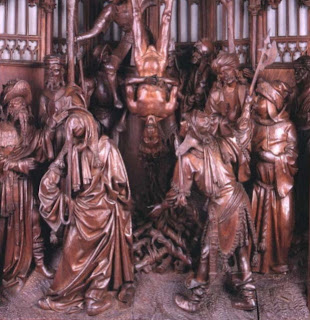Saturday, May 7th, 2011
Jumping Through History Each Week
This is the first quarter that I’ve taught four classes at the same time. And believe me – this is a busy time! It’s been interesting to teach so many different artistic periods during the same quarter; I’m constantly jumping between BC and CE dates. Next week’s lecture schedule seems particularly diverse:
Monday’s lecture:
Courbet, The Stone Breakers, 1849 (destroyed 1945)
(This lecture discusses the role of “avant-garde” art in connection with politics)
Tuesday’s lecture:
The architectural orders of ancient Greece
(This is an introductory lecture to ancient Greek art and architecture)
Wednesday’s lecture:
Daumier, Les Femmes Socialistes, c. 1848
(This lecture discusses how not all “avant-garde” artists align themselves with socially oppressed groups)
Thursday morning’s lecture:
Dipylon funerary krater, c. 700-750 BC
(This lecture is devoted to the connection between ancient Greek women and funerary vases)
Thursday evening’s lecture:
Jan Borman, detail from carved altarpiece of Saint George, 1493
(This lecture discusses the phenomenon of commercial altarpieces in the Northern Renaissance)
Friday’s lecture:
Ingres, The Grand Odalisque, 1814
(This lecture is devoted to postcolonial theory and popularity of Orientalist art in the 19th century)






Ohhh you have my total sympathy.
It is impossible to keep your mind straight, if you have to range over the entire world history of art each week. It is difficult enough to remember everything there is to know, even when you can concentrate on, say, just the Victorian Era.
But I am finding another problem. My passion was always for the 17th century, in Britain, Spain, Netherlands… anywhere really. But in the modern financial world, noone cares about your passion. The universities and TAFE colleges only care about bums on seats. So I am given courses largely from the mid 19th century on. Apparently students don't care too much about the Renaissance or the Early Modern Period 🙁
Four classes! When do you sleep??
In all the chaos I'm sure there will be moments of surprising harmony. When I was an undergrad student I had a day that included a lecture and slide show on Versailles and then a film on the Forbidden City. The subjects were amazingly similar but so different, a wonderful contrast – and a visually stunning day!
Extraordinary! I would like to atend to each one of your lectures. Very intersting!!
I use that same temple diagram for my intro to art course!
Each class sounds great! Good for you making it through!
Wow – you are busy! Happy days here at YDA because the last final I have to give is Wednesday.
Thanks for the comments (and sympathy!). I'm handling the juggle between the classes alright (especially since I've taught all of these classes before, so the prep time is minimized). It's just a really busy time, but I've been psychologically prepared for this chaos for several months.
V Span, there have been some surprisingly harmonious moments between my various lecture topics! In fact, I managed to integrate the Laocoon into all my lectures during one week, which surprised me so much that I wrote a post on the statue. It's fun when such harmonious moments can be found in seemingly different art history courses. Your example between Versailles and the Forbidden City is especially interesting.
Hi M! Your students are very lucky to have such an enthusiastic lecturer. If I lived nearby, I'd even sneak in your Thurday and Friday lectures.
Dont forget to tell them 'odalisque' is a Frenchified version of a Turkish word – "odali" – This literally means "has a room" but its connotation was of harem women who were so prominent as to have their own room/space.
Mixing it with the French, the meaning is very much an objectified one to our modern sensibilities, a woman whose primary role is to look beautiful and bestow pleasure.
This modern frowning at such objectification was increasingly less how the French of the Ingres era appreciated this picture, and quite far removed from women in the Ottoman Court, whom secretly wielded a great deal of power and influence.
It might also be worth highlighting to students how this differs from modern France. Back then, emulating the mysterious east was in vogue, whereas now they have the 'Burka ban'.
Times change…!
Kind Regards
H
PS- there is a also a great lecture on Ingres Odalisque on NGA Washington's podcast site you may want to refer your studenst to.
BRING ON THE COLUMNS AND POTS!!!
wow, those are quite the jumps!! can i sit in ALL your lectures?? i miss soaking in everything from those wonderful classes and i'm sure you are an AMAZING teacher. 🙂
Hasan, I like how you mentioned that the word "Odalisque" is "Frenchified." This ties in well with my upcoming lecture, in how these European representations of the Middle East and Far East are better indicative of European values (and European definitions of the "Orient") than of the actual places which were depicted. The French were more interested in the idea of an "odalisque" (and its connotations with harems/sexuality) than the literal translation of "odali."
Kelsey: You got it!
joolee: I miss being a student too. But I'm glad that I can continue to learn and grow as a professor. (Oh yeah, and I'm glad that I get paid to go to school now, instead of the other way around!)